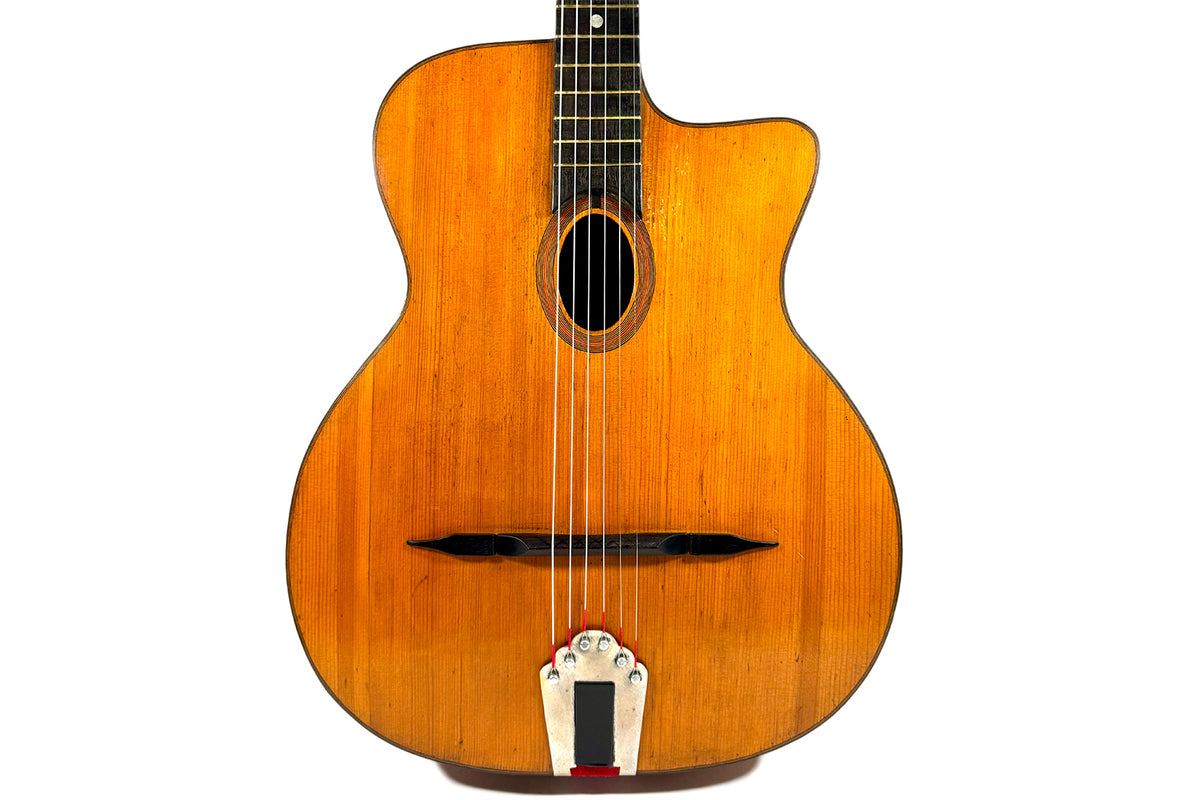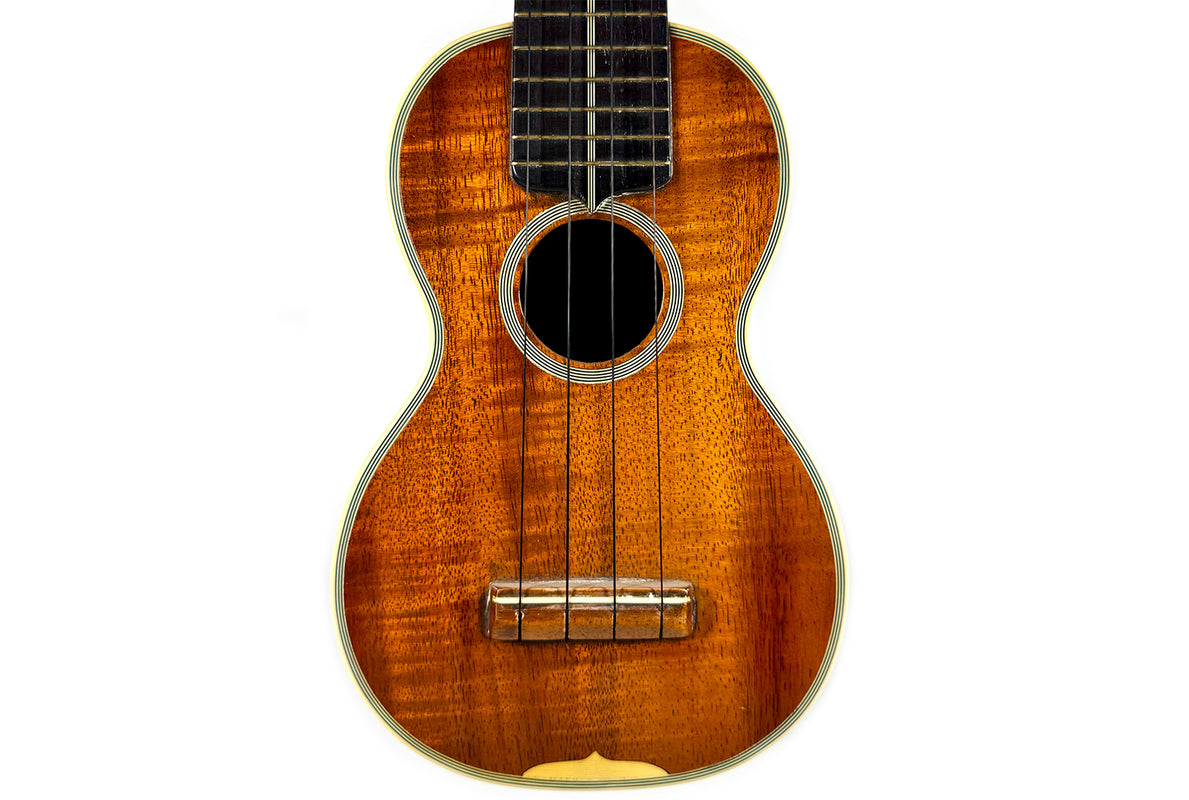
Martin 1-26 c.1870
La Martin 1-26 des années 1870 est une guitare vintage d’exception, symbole du raffinement artisanal de C.F. Martin & Co. à Nazareth, Pennsylvanie.
Héritière directe de la tradition initiée dans les années 1850, elle marque la transition historique entre C.F. Martin Sr. et C.F. Martin Jr., qui prend la direction en 1873.
Produite à seulement 270 exemplaires, la Martin 1-26 est aujourd’hui une guitare de collection rare et recherchée. Conçue pour une clientèle exigeante, elle associe une table en épicéa Adirondack à un dos et des éclisses en palissandre brésilien, des bois précieux réputés pour leur richesse harmonique.
Son barrage léger et son format parlor assurent une projection équilibrée, une réactivité exceptionnelle et une sonorité intimiste, idéale pour le jeu en fingerstyle. Entièrement fabriquée à la main, cette guitare Martin vintage séduit par ses basses profondes, ses médiums ambrés et ses aigus cristallins.
Véritable œuvre d’art sonore, la Martin 1-26 incarne l’union parfaite entre histoire, élégance et musicalité. Elle représente parfaitement la lutherie américaine de la seconde moitié du 19ème siècle, avec un timbre poétique et une chaleur inspirante.
Vidéo démo : https://youtu.be/jAnvYB1buTc
Davantage de détails dans l'annonce juste ici ! ⬇︎
Acoustic Guitars

Antoine DiMauro
Antoine Di Mauro was born in 1900 in Catania.
Before arriving in Paris in 1934 , he was already manufacturing guitars and mandolins in Catania. In 1942 , he moved to 47 Rue de la Réunion in the 20th arrondissement of Paris, in his famous workshop bearing the sign: “ LUTHERIE MODERNE ”.
Di Mauro guitars met with great success from the time . Particularly the Selmer Maccaferri type jazz guitar models like the Saint Louis Blues, the Boogie-Woogie and Special Chorus that Antoine Di Mauro created .
Many famous artists of the time played on a Di Mauro guitar: Jacques Brel , Georges Brassens , Henri Salvador , Sacha Distel , Jacques Higelin , Pat Metheny and of course Django Reinhardt.
Here, this model is a Chorus , certainly dating from the 1940s/1950s .
This is THE model created by Antoine Di Mauro , as indicated. A model particularly appreciated by musicians and very popular .
With these 14 frets outside the body, it is the perfect guitar for soloists .
The rest in the announcement right here! ⬇︎
Guitares Manouches

Rickenbacker & Rose Morris
It was during the 1950s that Rickenbacker began to turn to the manufacture of electric guitars . The brand enjoyed great success with the "Combo" model, a full-body guitar with distinctive curved shapes. Thus, Rickenbacker electric guitars quickly made a name for themselves thanks to their unique sound and elegant aesthetic .
It was then that in 1957 , Rickenbacker entered into a partnership with the British company Rose Morris . The latter was a major distributor of musical instruments in the United Kingdom. And this partnership has allowed Rickenbacker to expand its presence in the British market . Rickenbacker guitars were distributed by Rose Morris in the United Kingdom under the brand name "Rose Morris Rickenbacker" or "RM Rickenbacker".
This partnership with Rose Morris also contributed to the growth of the Rickenbacker brand in the 1960s . The Beatles , among others, played a major role in popularizing Rickenbacker guitars . George Harrison used a Rickenbacker 360/12 guitar during the recording of the song "A Hard Day's Night" in particular, which sparked considerable interest in the brand's instruments .
The rest of the story is in the announcement right here! ⬇︎
Electric Guitars

The Violaline
Very beautiful and rare example of concert violaline by Jérôme Thibouville Lamy , dated from the beginning of the 20th century (1901-1912).
Patented at the very beginning of the century, the Violaline is a hybrid instrument between the violin and the mandolin . Although the instrument has a shape and construction more reminiscent of the violin, the mechanical head, the 4 choirs and the flat radius of the fingerboard indicate that it is played like a mandolin , that is to say say to the plectrum.
A page from the JTL catalog dating from 1901, the date on which the patent would have been filed, provides information on the start of the marketing of the instrument.
The violaline was offered at least until 1912 when it still appears in the JTL catalog.
So here is a very beautiful violaline model dating from the beginning of the 20th century in a sumptuous curly maple and in a superb state of conservation and play .
The rest in the announcement right here! ⬇︎
Mandolins

Joseph Pons - "Pons Son"
Very beautiful lyre guitar made by Joseph Pons , known as " Pons fils " in Paris in the year 13, i.e. between September 1804 and September 1805 .
In the Pons family, he is the eldest son of Césars Pons , known as "Pons Père" who lived between 1748 and 1831. The latter is known in particular for his guitar-lyres , but also for his organized hurdy-gurdies including the King of Naples Ferdinand I of the Two Sicilies, said Ferdinand IV was fond of.
Thus his eldest son Joseph, like his brother Louis-David , apprenticed as luthiers with Nicolas Maréchal , active between 1770 and 1810. The latter also claims the paternity of the invention of the lyre guitar.
And it is therefore natural that Joseph Pons produced lyre guitars from the start of his production , installed in Paris at number 5 Rue du Grand Hurleur, which was certainly the first address of his workshop in the capital.
And it was approximately 7 years after the manufacture of this lyre guitar offered for sale here, that is to say in 1812 the year of the Russian campaign, that Emperor Napoleon I in turn ordered a lyre guitar to Joseph Pons .
The latter was acquired by the Emperor as a gift to his wife, Empress Marie-Louise, who herself donated it to her favorite musician, the Italian composer Mauro Giuliani.
In fact, Joseph Pons enjoyed obvious recognition in his time for his qualities as a luthier and more particularly here concerning his lyre guitars.
The rest in the announcement right here! ⬇︎
Classical Guitars

Ukuleles Martin Style 1
Rare and beautiful model of Cavaquinho manufactured by Tranquillo Giannini during the 1950s in São Paulo, Brazil .
It was in 1900 that Tranquillo Giannini , a talented Italian luthier , established the Giannini guitar brand in Brazil, in São Paulo , specializing in the manufacture of high quality classical guitars and other folk instruments.
In 1933 , the Giannini brand began to gain notoriety in the Brazilian music scene through the production of high quality acoustic guitars , quickly becoming the choice of local artists .
And in 1950 , Giannini innovated by becoming the first company to create electric guitars with an aluminum body.
Then, the 1960s saw Giannini expand its product line to include high-quality electric guitars , basses , folk guitars and classical guitars.
And it was in the 1970s that Giannini became one of the most recognized guitar brands in Brazil and South America , with strong adoption by renowned Brazilian artists.
The rest of the announcement right here! ⬇︎
Other Instruments

Roland System 100 Model 101
Le Roland System 100 Model 101, sorti en 1975, est un synthétiseur analogique monophonique mythique, conçu par la firme japonaise Roland comme le cœur du système semi-modulaire System 100, produit jusqu’en 1979. Véritable icône des synthétiseurs des années 70, il offrait une alternative plus abordable aux systèmes modulaires complets, tout en conservant une qualité sonore exceptionnelle.
Pensé comme une solution de studio modulaire complète, le Model 101 pouvait être combiné avec d'autres modèles. Grâce à sa chaleur analogique et à sa précision de modulation, il est rapidement devenu un instrument culte dans les studios de musique électronique.
Le Roland System 100 a été utilisé par des artistes majeurs comme Martyn Ware (The Human League, Heaven 17), Daniel Miller (Depeche Mode, Mute Records), Vangelis, Tangerine Dream, Aphex Twin, Orbital, Front 242 ou Vince Clarke. Sur des albums emblématiques tels que Reproduction ou Travelogue, on retrouve ses lignes de basse puissantes, ses textures modulées riches et ses effets rythmiques précis, qui ont façonné le son de la musique électronique des années 70 et 80.
Ce Roland System 100 Model 101 demeure aujourd’hui un synthétiseur analogique vintage légendaire, recherché pour sa sonorité chaude, sa modulation expressive et sa polyvalence créative. Un véritable classique de la synthèse analogique, idéal pour les musiciens, producteurs et collectionneurs passionnés à la recherche d’un son authentique et intemporel.
Davantage d'informations dans l'annonce juste ici ! ⬇︎
Effets

Gibson BR-6 de 1953
The Bandmaster was introduced by Fender in 1953 . In 1963 , it was fitted for the first time with a Blonde tolex as well as a golden grille . This model dates from 1964 . In superb condition for its age. It has all these period accessory pieces. The amp consists of a head and its cabinet made up of two 12" speakers.
Channel 1 ("Normal"):
- Inputs: High and Low
- Controls: Bright / Volume / Treble / Bass
Channel 2 (“Vibrato”):
- Inputs: High and Low
- Controls: Bright / Volume / Treble / Bass
- Vibrato controls: Speed / Intensity
The sound is typical of the Fender sound of the time . The amp brings out clean sounds perfectly while maintaining superb warmth . It also accepts effect pedals without any problem. The vibrato can be as subtle as it is very pronounced.
In short, a superb vintage amp that sounds fantastic!
The rest of the story is in the announcement right here! ⬇︎
Amps

Banjo Stewart "20th Century"
Wasburn is an American company that began manufacturing guitars , mandolins, banjos , banjolines , etc. in 1883 in Chicago . Originally, it was a division of Lyon & Healey and Washburn-branded instruments were their flagship line .
Many agree to say, then as today, that Washburn banjos are among the best banjos , without obviously forgetting the Gibson, Bacon & Day, Vega, Gold Tone banjos to name a few.
But Washburn banjos remain the most popular among banjo players because of their excellent sound , very good design and construction at an affordable price .
So Washburn banjos have very good value for money .
The announcement right here! ⬇︎
Banjos

The O'Hagan story
Jerry O'Hagan, was born in 1942 in the western suburbs of Minneapolis. He studied music at school and until 1971/1972 he made his living teaching and playing music in music stores.
As a result of this work, in 1971/1972, he began working as a representative for the Chicago musical instrument distributor: Targ and Dinner, which notably distributed Guild brand guitars.
He then worked at Meloway, notably distributor of a brand of Japanese acoustic guitars: Yamaki.
Following this employment at Meloway and after admiring the quality of Yamaki guitars, he decided to embark on the adventure of Japanese guitars too.
And it was in 1975 that Jerry O'Hagan created his own import company and began marketing Grande brand acoustic guitars from Japan.
But he stopped these imports three years later in 1978.
And it was in 1978/1979 that he began manufacturing and marketing his own guitars and basses after developing the Shark model.
O'Hagan Guitars was born!
The rest of the story is in the announcement right here! ⬇︎


























































































































































































































































































































